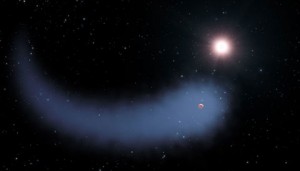Yes, apart from WASP-69b, there has been reports of other exoplanets emitting some form of planetary tails. Let's start from the Wikipedia:
KIC 12557548 b is a small rocky planet, very close to its star, that is evaporating and leaving a trailing tail of cloud and dust like a comet. The dust could be ash erupting from volcanos and escaping due to the small planet's low surface-gravity, or it could be from metals that are vaporized by the high temperatures of being so close to the star with the metal vapor then condensing into dust.
In June 2015, scientists reported that the atmosphere of GJ 436 b was
evaporating, resulting in a giant cloud around the planet and, due to
radiation from the host star, a long trailing tail 14 million km (9
million mi) long.
More on the dust particles that is trailing from the exoplanets KIC 12557548 b as well as KOI-2700b:
The observed tail lengths are consistent with dust grains composed of
corundum (Al2O3) or iron-rich silicate minerals (e.g., fayalite,
Fe2SiO4). Pure iron and carbonaceous compositions are not favored. In
addition, we estimate dust mass loss rates of 1.7 ± 0.5 M⊕ Gyr-1 for
KIC 12557548b, and > 0.007 M⊕ Gyr-1 (1σ lower limit) for KOI-2700b.
Source: Dusty tails of evaporating exoplanets, I. Constraints on the dust composition, R. van Lieshout1, M. Min and C. Dominik, A&A, Volume 572, December 2014, DOI: 10.1051/0004-6361/201424876
Astronomers using NASA's Hubble Space Telescope have confirmed the
existence of a baked object that could be called a "cometary planet."
The gas giant planet, named HD 209458b, is orbiting so close to
its star that its heated atmosphere is escaping into space.
Source: https://www.nasa.gov/mission_pages/hubble/science/planet-tail.html
Astronomers have confirmed that the planet Gliese 436b seems to be
trailing a gigantic, comet-like cloud of hydrogen.

Source: https://skyandtelescope.org/astronomy-news/exoplanet-with-a-comet-tail-06302015234/
Disintegrating planets allow for the unique opportunity to study the
composition of the interiors of small, hot, rocky exoplanets because
the interior is evaporating and that material is condensing into dust,
which is being blown away and then transiting the star. Their transit
signal is dominated by dusty effluents forming a comet-like tail
trailing the host planet K2-22b, making these good candidates for
transmission spectroscopy.
Source: Eva H. L. Bodman et al 2018 AJ 156 173, DOI: 10.3847/1538-3881/aadc60

tailis the best and clearest name for a tag for planetary tails? I wonder if it should be "planetary-tail"since questions about cometary tails are more complex in nature, much more numerous and already covered bycomets? $\endgroup$